1997 CHEVROLET MONTE CARLO heater
[x] Cancel search: heaterPage 194 of 358
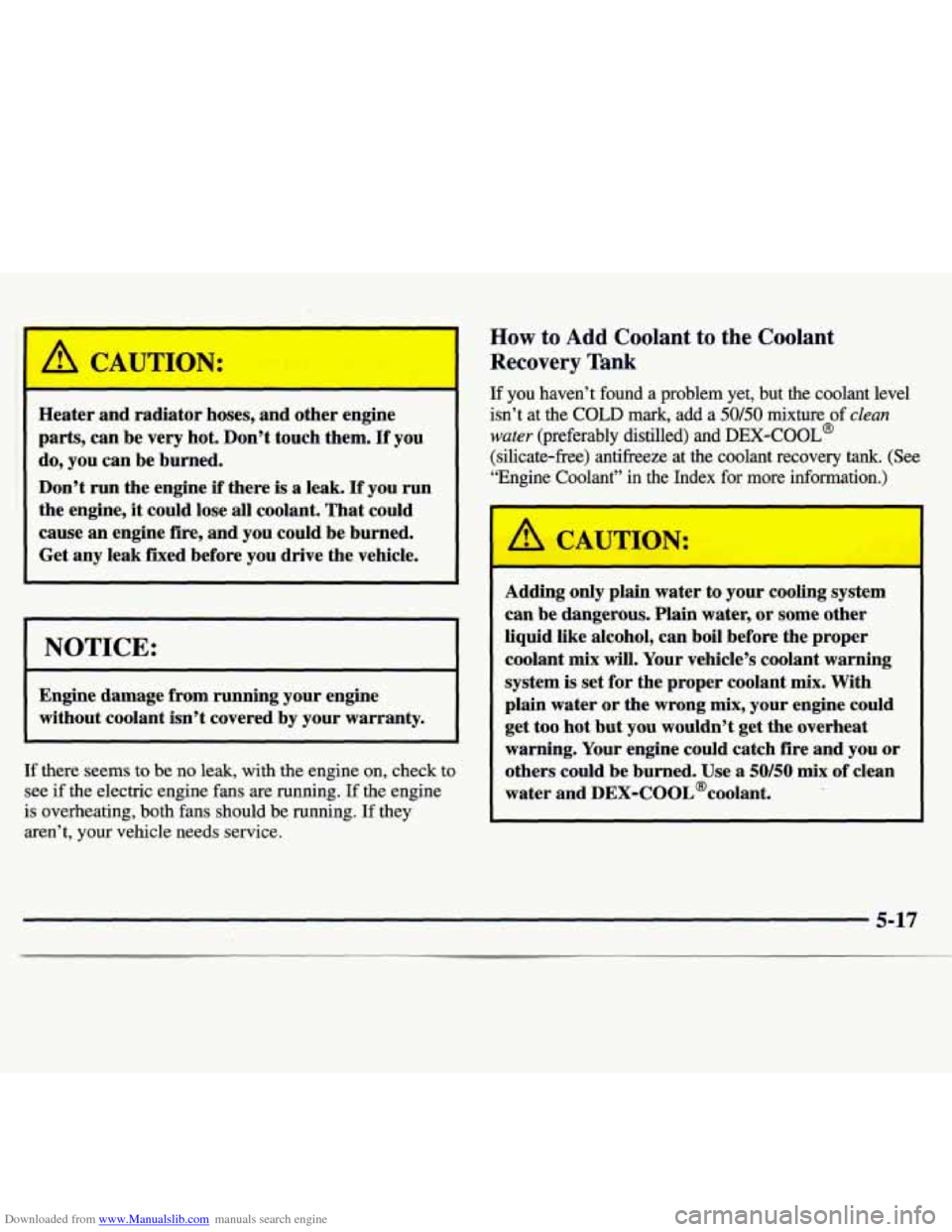
Downloaded from www.Manualslib.com manuals search engine Heater and radiator hoses, and other engine
parts, can be very hot. Don’t touch them.
If you
do, you can be burned.
Don’t run the engine
if there is a leak. If you run
the engine, it could lose all coolant. That could
cause an engine fire, and you could be burned.
Get any leak fixed before you drive the vehicle.
NOTICE:
Engine damage from running your engine
without coolant isn’t covered by your warranty.
If there seems to be no leak, with the engine on, check to
see
if the electric engine fans are running. If the engine
is overheating, both fans should be running.
If they
aren’t, your vehicle needs service.
How to Add Coolant to the Coolant
Recovery Tank
If you haven’t found a problem yet, but the coolant level
isn’t at
the COLD mark, add a 50/50 mixture of clean
water (preferably distilled) and DEX-COOL@
(silicate-fiee) antifreeze at the coolant recovery tank. (See
“Engine Coolant” in the Index for more information.)
’ Adding only plain water to your cooling system
can be dangerous. Plain water,
or some other
liquid like alcohol, can boil before the proper
coolant
mix will. Your vehicle’s coolant warning
system is set for the proper coolant mix. With
plain water or the wrong
mix, your engine could
get too hot but
you wouldn’t get the overheat
warning. Your engine could catch fire and you or
others could be burned. Use a
50/50 mix of clean
water and DEX-COOL%oolant.
5-17
--
Page 195 of 358
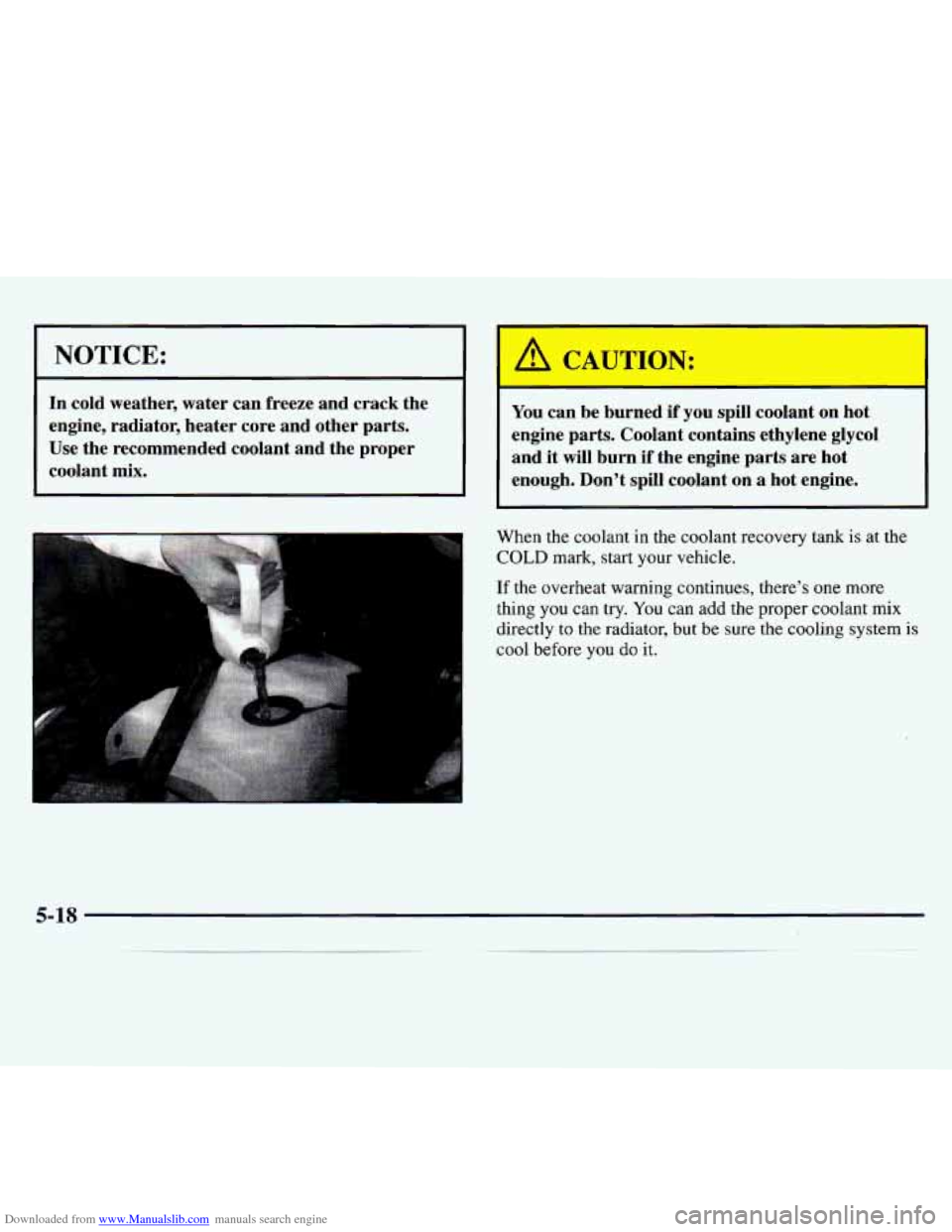
Downloaded from www.Manualslib.com manuals search engine NOTICE: I
In cold weather, water can freeze and crack the
engine, radiator, heater core and other parts.
Use the recommended coolant and the proper
coolant mix.
I A CAUTION:
- - I
You can be burned if you spill coolant OII not
engine parts. Coolant contains ethylene glycol
and it will burn if the engine parts are hot
enough. Don’t spill coolant on
a hot engine.
When the coolant in the coolant recovery tank is at the
COLD mark, start your vehicle.
If the overheat warning continues, there’s
one more
thing you can try. You can add the proper coolant
mix
directly to the radiator, but be sure the cooling system is
cool before you
do it.
5-18
Page 198 of 358
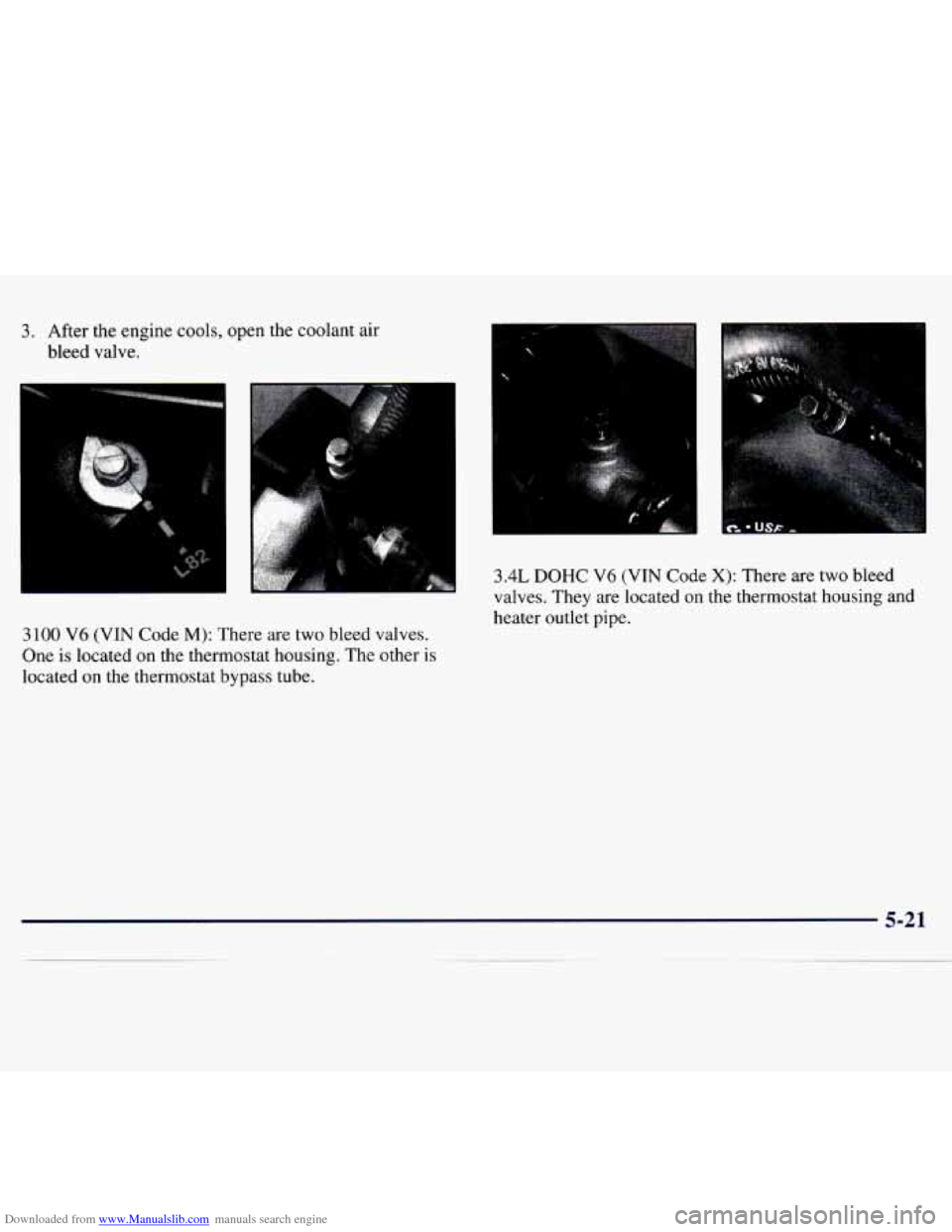
Downloaded from www.Manualslib.com manuals search engine 3. After the engine cools, open the coolant air
bleed valve.
3 100 V6 (VIN Code M): There are two bleed valves.
One is located on the thermostat housing. The other is
located
on the thermostat bypass tube.
3.4L DOHC V6 (VTN Code X): There are two bleed
valves.
They are located on the thermostat housing and
heater outlet pipe.
Page 236 of 358

Downloaded from www.Manualslib.com manuals search engine NOTICE:
When adding coolant, it is important that you use
only
DEX-COOL@ (silicate-free) coolant.
If coolant other than DEX-COOL is added to the
system, premature engine, heater core or
radiator corrosion may result.
In addition, the
engine coolant will require change sooner
-- at
30,000 miles
(50 000 km) or 24 months,
whichever occurs
first. Damage caused by the use
of coolant other than DEX-COOL@ is not
covered by your new vehicle warranty.
What to Use
Use a mixture of one-half clean water (preferably
distilled) and one-half
DEX-COOL@ coolant which
won’t damage aluminum
parts. If you use this mixture,
you don’t need to add anything else.
Adding only plain water to your cooling system
can be dangerous. Plain water, or some other
liquid like alcohol, can boil before the proper
coolant mix will. Your vehicle’s coolant warning
system is set for the proper coolant mix. With
plain water or the wrong mix, your engine could
get too hot but you wouldn’t get the overheat
warning. Your engine could catch fire and you or
others could be burned. Use a
50/50 mix of clean
water and DEX-COOL@ coolant.
Page 237 of 358
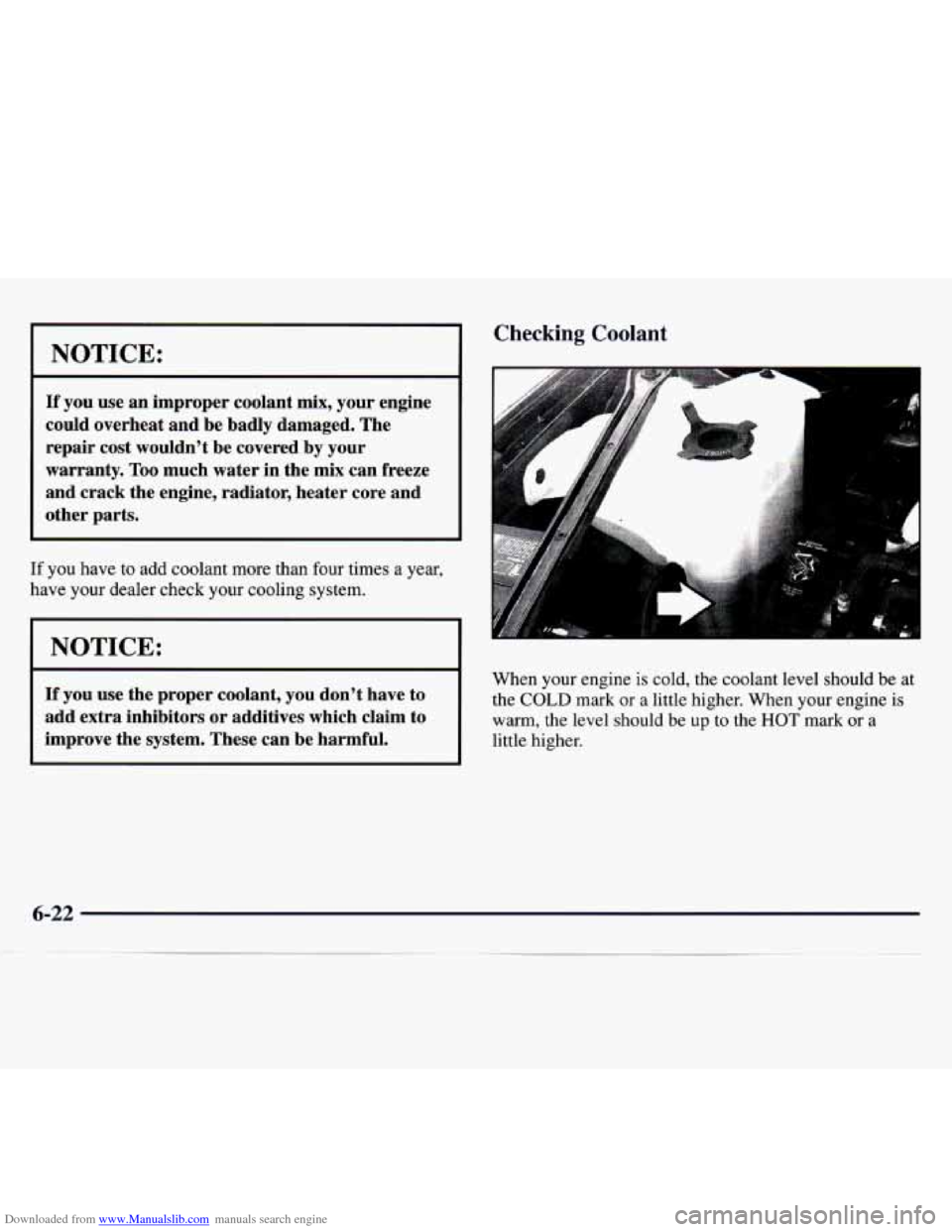
Downloaded from www.Manualslib.com manuals search engine NOTICE:
If you use an improper coolant mix, your engine
could overheat and be badly damaged. The
repair cost wouldn’t be covered by your
warranty.
Too much water in the mix can freeze
and crack the engine, radiator, heater core and
other parts.
If you have to add coolant more than four times a year,
have your dealer check your cooling system.
I NOTICE: I
If you use the proper coolant, you don’t have to
add extra inhibitors or additives which claim to
improve the system. These can
be harmful.
Checking Coolant
When your engine is cold, the coolant level should be at
the
COLD mark or a little higher. When your engine is
warm, the level should be
up to the HOT mark or a
little higher.
6-22
Page 282 of 358
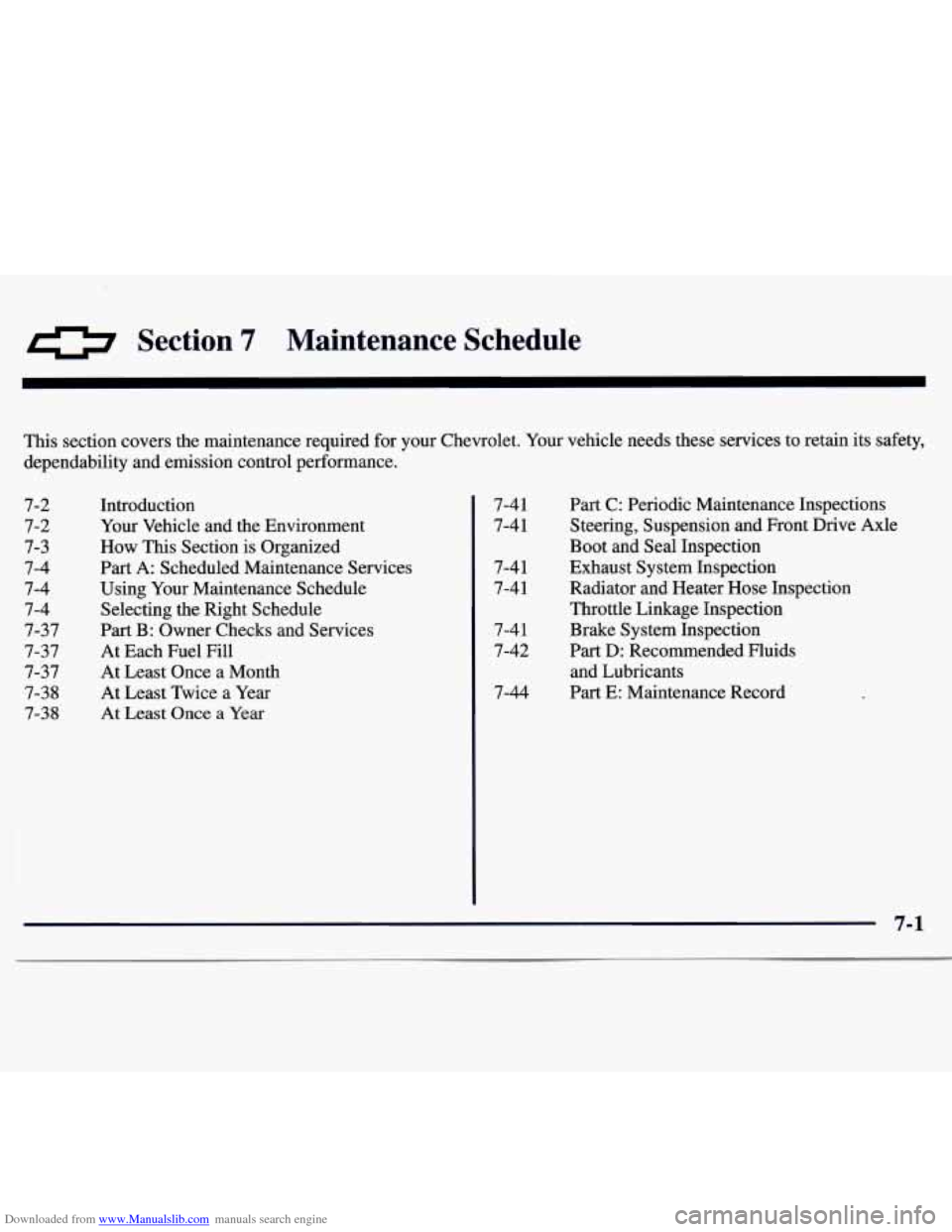
Downloaded from www.Manualslib.com manuals search engine Section 7 Maintenance Schedule
This section covers the maintenance required for your Chevrolet. Your vehicle needs these services to retain its safety,
dependability and emission control performance.
7-2
7-2 7-3
7-4
7-4
7-4
7-37
7-37
7-37 7-38
7-38
Introduction
Your Vehicle and the Environment
How This Section is Organized
Part A: Scheduled Maintenance Services
Using Your Maintenance Schedule
Selecting the Right Schedule
Part B: Owner Checks and Services
At Each Fuel
Fill
At Least Once a Month
At Least Twice a Year
At Least Once
a Year
7-41
7-41
7-4
1
7-4 1
7-4 1
7-42
7-44
Part C: Periodic Maintenance Inspections
Steering, Suspension and Front Drive
Axle
Boot and Seal Inspection
Exhaust System Inspection
Radiator and Heater Hose Inspection
Throttle Linkage Inspection
Brake System Inspection
Part D: Recommended Fluids
and Lubricants
Part E: Maintenance Record
7-1
Page 322 of 358

Downloaded from www.Manualslib.com manuals search engine Part C: Periodic Maintenance
Inspections
Listed below are inspections and services which should be
performed at least twice a year (for instance, each spring
and fall). You should let your
GM dealer’s service
department or other qualified service center
do these jobs.
Make sure any necessary repairs are completed at
once.
Proper procedures to perform these services may be
found in a
GM service manual. See “Service and Owner
Publications” in the Index.
Steering, Suspension and Front Drive Axle
Boot and Seal Inspection
Inspect the front and rear suspension and steering
system for damaged, loose or missing parts, signs of
wear
or lack of lubrication. Inspect the power steering
lines and hoses for proper hook-up, binding, leaks,
cracks, chafing, etc. Clean and then inspect the drive
axle boot seals for damage, tears or leakage. Replace
seals if necessary.
Exhaust System Inspection
Inspect the complete exhaust system. Inspect the body
near the exhaust system. Look for broken, damaged,
missing or out-of-position parts as well as open seams, holes, loose connections or other conditions
which could
cause a heat build-up in the floor pan or could let
exhaust fumes into the vehicle. See “Engine Exhaust” in
the Index.
Radiator and Heater Hose Inspection
Inspect the hoses and have them replaced if they are
cracked, swollen or deteriorated. Inspect all pipes,
fittings and clamps; replace as needed.
Throttle Linkage Inspection
Inspect the throttle linkage for interference or binding,
and for damaged or missing parts. Replace parts as
needed. Replace any cables that have high effort or
excessive wear.
Do not lubricate accelerator and cruise
control cables.
Brake System Inspection
Inspect the complete system. Inspect brake lines and
hoses for proper hook-up, binding, leaks, cracks,
chafing, etc. Inspect disc brake pads for wear and rotors
for surface condition. Also inspect drum brake linings
for wear and cracks. Inspect other brake parts, including
drums, wheel cylinders, calipers, parking brake,
etc.
Check parking brake adjustment. You may need to have
your brakes inspected more often if your driving habits
or conditions result in frequent braking.
7-41
Page 348 of 358

Downloaded from www.Manualslib.com manuals search engine Climate Control System ........................... 3-2
Clock. Setting the
................................ 3-6
Comfort Controls
................................ 3- 1
Compact Disc Care
............................. 3-20
Compact Disc Player
............................ 3- 11
Compact Disc Player Errors ....................... 3- 14
Compact Spare Tire
............................. 5-35
Console Storage
................................ 2-39
Control
of a Vehicle .............................. 4-6
ConvenienceNet
............................... 2-39
Convex Outside Mirror
.......................... 2-37
Coolant
....................................... 6-20
Adding
..................................... 6-23
Bleedvalves
................................. 5-21
Checking
................................... 6-22
Heater. Engine
............................... 2- 15
RecoveryTank ............................... 5-17
Whattouse ................................. 6-21
Cooling System
................................ 5- 15
Courtesy
Lamps ................................ 2-35
Courtesy Transportation
........................... 8-8
Cruise Control ................................. 2-30
Cupholders
............................... 2-37. 2-38
Customer Assistance for Text Telephone Users
......... 8-4
Customer Assistance Information
................... 8- 1
Customer Satisfaction Procedure
.................... 8-2
Damage. Finish
............................... 6-52
Damage. Sheet Metal
............................ 6-5 1
Daytime Running Lamps ......................... 2-34 Dead Battery
................................... 5-3
Defects. Reporting Safety
........................ 8-10
Defensive Driving ............................... 4-2
Defogger. Rear Window
.......................... 3-6
Defogging
..................................... 3-5
Defrosting ..................................... 3-5
Dimensions. Vehicle ............................ 6-64
Dolby@
B Noise Reduction ....................... 3-10
Dome Lamp Bulb Replacement .................... 6-36
DoorLocks
..................................... 2-4
Door Storage Compartment
....................... 2-38
Drive Position. Automatic Transaxle
................ 2-18
DriverPosition
................................. 1-13
Driving
City
........................................ 4-19
Defensive .................................... 4-2
Drunken
..................................... 4-3
Freeway
.................................... 4-20
InaBlizzard
................................. 4-26
In Foreign Countries
........................... 6-4
IntheRain
.................................. 4-16
Night
...................................... 4-14
OnCurves ................................... 4-9
On Grades While Towing a Trailer
............... 4-36
On Hill and Mountain Roads
.................... 4-22
On Snow and Ice
............................. 4-25
Throughwater
............................... 4-18
WetRoads .................................. 4-16
Winter
...................................... 4-24
With a Trailer
................................ 4-34
DrunkenDriving
................................ 4-3
9-3
. ...... -,-.--- ..